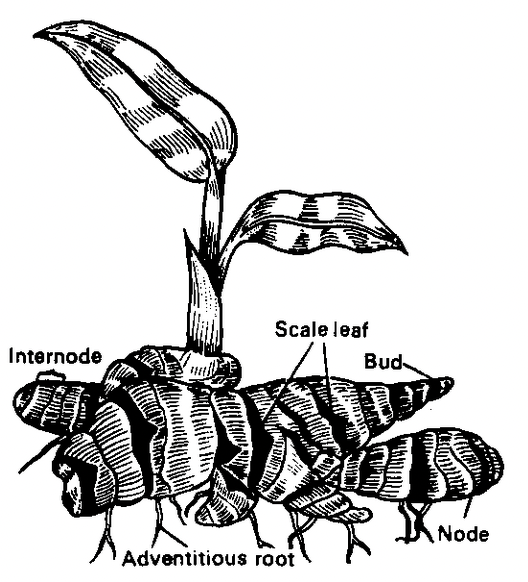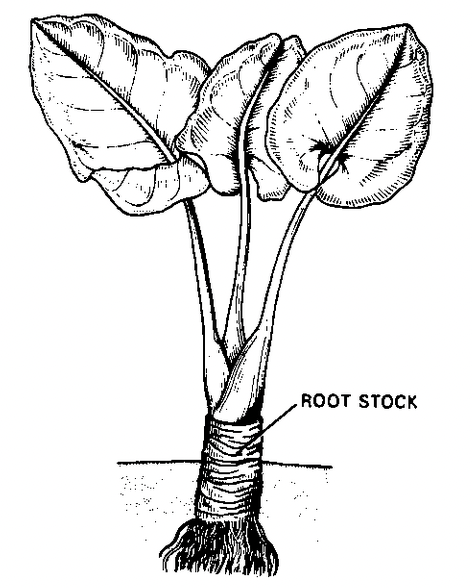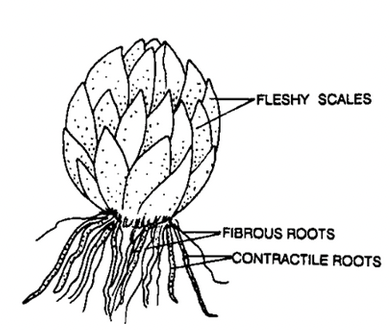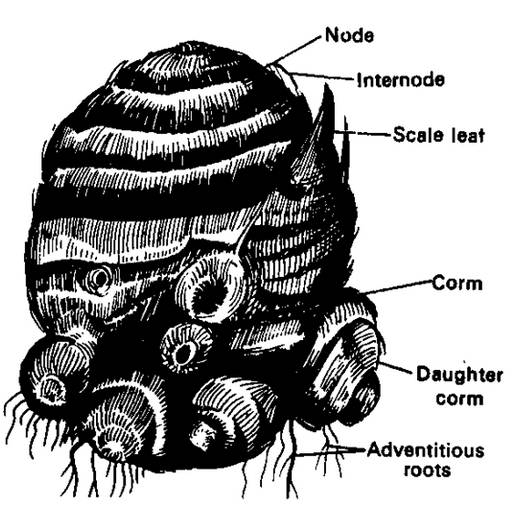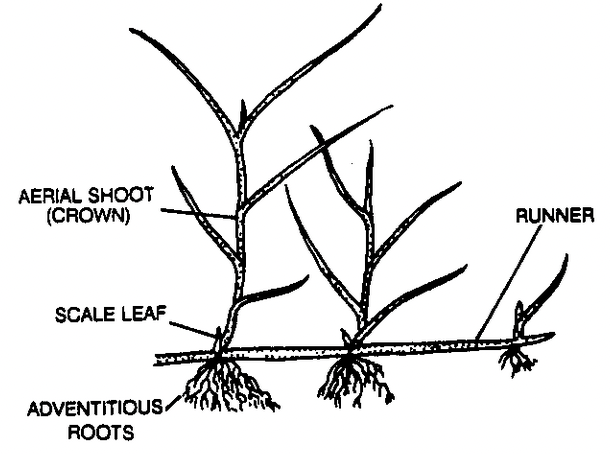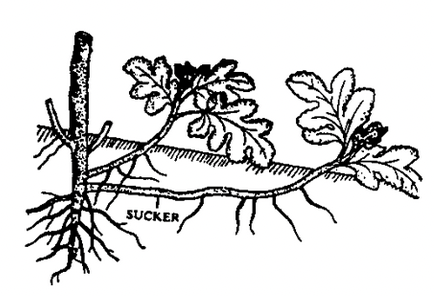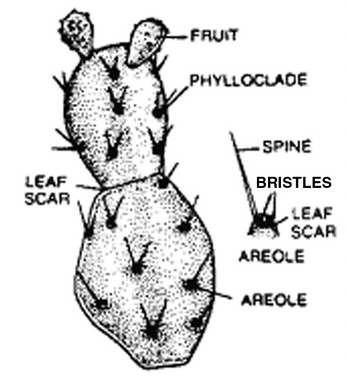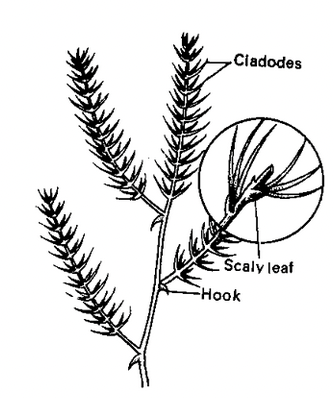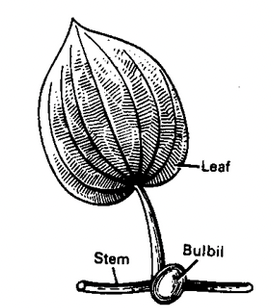
Stem
Morphology Of Angiosperm of Class 11
Stem is the ascending organ of the plant which originates from plumule and grows towards sunlight, away from the centre of earth.
CHARACTERISTICS OF STEM
- It is positively phototropic and negatively geotropic and hydrotropic.
- It is green at young stage but becomes brown or deep brown on maturity.
- It is differentiated into nodes and internodes.
- The nodes bear leaves and branches which arise exogenously.
- Stem hairs are multicellular and are called trichomes.
- ❒Stem apex is always apical, terminated by an apical bud.
BUD
- A young undeveloped shoot with an immature axis having a growing point surrounded by many closely packed tender leaves, is called bud.
types of buds
According to their nature, buds are of three types:
- Vegetative: They form only leafy shoots.
- Floral: These are reproductive buds that form flowers.
- Mixed: They form both branches and flowers.
According to their position, buds are of mainly two types:
normal and adventitious.
- Normal bud: Bud present on stem and its branches is called normal bud. It is of following types:
- Terminal or apical buds: It is present at the apex of the stem and its branches and is responsible for increase in length.
- Axillary or lateral buds: They are borne in the axils of leaves and develop into branches or flowers.
- Accessory buds: They are additional buds which develop in the leaf axil either on the side (collateral) or above (superposed) the axillary bud. They commonly form stem modifications like thorns, etc, e.g. Duranta.
- Extra-axillary buds: They develop on the node but outside the leaf base, e.g., Cucurbita.
- Adventitious buds: These are the buds which are formed from places other than nodes. These are of following three types:
- Radical buds: They develop on the root, e.g., Ipomoea, Dalbergia, etc.
- Foliar or epiphyllous buds: Such buds grow over the leaf, e.g., Bryophyllum. Begonia, Kalanchoe, etc.
- Cauline buds: They arise directly from the stem in the regions of injury e.g., rose (Rosa indica). Jack fruit (Artocarpus integrifolia), etc.
- On the basis of activity, buds may be active or dormant.
- They may be naked or covered. A bud may be covered by bud scales, e.g. Ficus.

Fig. Types of vegetative buds
BRANCHING OF STEMS
- A branch may be defined as a lateral appendage arising from the axil of a leaf, differentiated into nodes and internodes like main stem. The large branches are usually called boughs while the smallest undeveloped ones are called twigs.
- The mode of arrangement of branches on the main stem is known as branching. The type of branching determines the shape of the plant. There are two principal types of branching, lateral and dichotomous.
- Lateral or axillary branching: When the branches are produced laterally from lateral bud present on the main stem, the branching is called lateral. It is of following two types:
- Racemose or indefinite or monopodial branching: In this type the growth of main stem is indefinite and lateral branches arise in an acropetal succession, e.g.. Casuarina, mast tree (Polyalthia longifolia), Petunia, etc. Because there is one main axis, the branching is called monopodial branching. The branches provide a conical or pyramidal outlook to the crown.
- Cymose or definite branching: In this type the growth of main stem is checked by the formation of a terminal flower and lateral branches arise in a basipetal succession.On the basis of number of lateral branches arising once, it is of following three types:
- Uniparous cyme: In this type one lateral branch arises once. It is otherwise called sympodial because there is a succession of daughter axes (false axes) fused together in the course of the plant’s development. It has two distinct forms:
- Helicoid cyme: Type of uniparous cyme successive lateral branches develop on the same side, forming a sort of helix, e.g., seeta ashok (Saraca indica).
- Scorpioid cyme: Type of uniparous cyme successive lateral branches develop on alternate sides, forming a zigzag, e.g., vine (Vitis vinifera), wild vine (V. trifolia), harhjora (Cissus quadrangularia), etc.
- Biparous cyme: In this type two lateral branches arise once, e.g., four O’clock plant (Mirabilis jalapa), temple or pagoda tree (Plumeria acutifolia) karonda (Carissa carandas), takla (Silene saxifraga), mistletoe (Viscum album), etc.
- Multiparous cyme: In this type more than two lateral branches arise once, e.g.,Croton sparciflorus, some species of Euphorbia, Nerium odoratus (oleander), etc.
- Dichotomous branching: When the terminal bud bifurcates producing two branches in a forked manner, the branching is termed dichotomous. It is common among the cryptogams and also occurs in some angiosperms like screwpine (Pandanus). Clinogyne dichotoma, etc.

Dichotomous Racemose Scorpioid Helicoid

Biparous Multiparous
Fig. Types of branching
MODIFICATIONS OF STEMS
❒ Change in form to perform functions other than normal is called modification. To perform different functions, stem gets modified variously. On the basis of habitat, modified stems can be classified into three categories: Underground modifications, Sub-aerial modifications and Aerial modifications.
Underground modifications of stem
- After modification such stems become subterranean and are meant for storage of food, perennation and vegetative reproduction. Underground modifications of stem are of following types:
- Rhizome: It is a modified main stem, which grows horizontally under the surface of the soil, exhibiting diageotropic mode of growth. It is thick, prostrate, dorsiventral and branched and has distinct nodes and internodes. The nodes bear small scaly leaves in the axils of which, there are axillary buds. Adventitious roots develop on the lower surface of the nodes. Food materials are stored in both nodes and internodes. Rhizome is of two types:
- Rootstock: Vertical or oblique rhizome with the tip almost reaching the soil surface, e.g., banana (Musa sapientum), mankand (Alocasia indica), Dryopteris (a fern), etc.
- Straggling: It is horizontally branched rhizome, e.g., ginger (Zingiber qfficinale), turmeric (Curcuma domestica = C. longa), Canna, lotus (Nelumbium spaciosum), water lily (Nymphaea sp.), etc.
|
Fig. Straggling of Ginger |
Fig. Rootstock of Alocasia |
• Tuber: It is the swollen end of a special underground branch. It is round or oval or cylindrical in shape growing horizontally under the ground. It develops at the tip of highly branched stolon that arises from the axil of a lower leaf. The stem tuber is covered by a corky skin. Apical end of tuber is called rose end while the basal end is called heel end. Each tuber possesses a number of spirally arranged depressions called eyes, each representing a node. The eyes are more crowded towards the rose end. At each node there is a scaly leaf in the axil of which, a bud is present. Adventitious roots are absent. There is a heavy deposit of food material, e.g., potato (Solanum tuberosum), Jerusalem artichoke (Helianthus tuberosus), Chinese artichoke (Stachys tuberifera), etc.

Fig. Stem tuber of Potato
• Bulb: It is highly reduced underground modified main stem. It assumes a disc or convex-lens or cone-shape. Nodes are very closely situated so internodes are very small. From upper surface of nodes scaly leaves are borne and from their lower surface numerous adventitious roots arise. Scaly leaves are of two types: outer, dry, brown and inner fleshy, white or red scaly leaves. Fleshy scaly leaves store food at their base in the form of carbohydrates. At the apex of bulb there is an apical bud which gives rise to an aerial shoot, known as scape. In the axils of fleshy scaly leaves, axillary buds develop. According to the arrangement of fleshy scaly leaves, there are two types of bulbs:
- Tunicated bulb: In this type fleshy scales are arranged in a concentric manner and the whole bulb is covered by a sheath of dry membranous scales called tunic, e.g., onion (Allium cepa), tulip (Tulipa), hyacinth (Hyacinthus), tuberose (Polyanthes), etc.
Characteristic smell of onion is due to sulphur-allyl sulphide present in fleshy leaves.
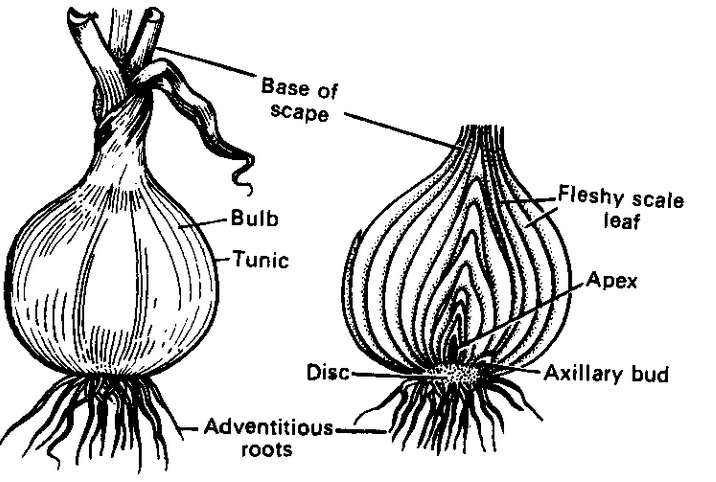
Fig. Tunicated bulb of Onion
|
Fig. Scaly bulb of Lily |
|
Fig. Corm of Colocasia |
Sub-aerial modifications of stem
- These are modified branches, which either grow along the surface of the soil or may be partially underground. These are mainly meant for vegetative reproduction and perennation. Sub-aerial modifications of stem are of following four types:
|
Fig. Runner of Grass |
A special type of underground runner with three internodes is the sobole. It is sometimes included into rhizomes but it is thin and does not store food, e.g., couch grass (Agropyron), kans (Saccharum spontaneum), ulu (Imperata arundinacea), etc.
|
Fig. Stolon of wild strawberry |
|
Fig. Sucker of Chrysanthemum |
|
Fig. Offset of Pistia |
Aerial Modifications of stem
❒ To perform some special functions like climbing, protection, food manufacture, vegetative reproduction, etc., vegetative and floral buds often undergo modification in certain plants. The various aerial modifications of stem are as follows:
|
Fig. Phylloclade of Opuntia |
|
Fig. Cladode of Asparagus |
- Thorns: It is a hard, straight and pointed structure meant for protection. It may arise from axillary bud, e.g., garden hedge plant (Duranta), lemon (Citrus), pomegranate (Punica), moyna (Vangueria), etc. or from apical bud, e.g., karonda (Carissa). It may bear leaves, flowers and fruits, e.g., Duranta, Prunus, etc. It may be branched e.g., Carissa carandas and Flacourtia cataphracta.

Fig. Thorns of Duranta and Carissa
- Stem tendril: It is a thin, wiry, leafless, spirally coiled and sensitive structure meant for climbing. It may be branched or unbranched. Branched stem tendrils may bear scale leaves in the region of forking. It may arise from axillary bud, e.g., passion flower (Passiflora suberosa) or from apical bud, e.g., Vitis, or from extra-axillary buds, e.g., Cucurbits, or from floral bud, e.g., sandwitch island climber (Antigonon) and balloon vine (Cardiospermum).
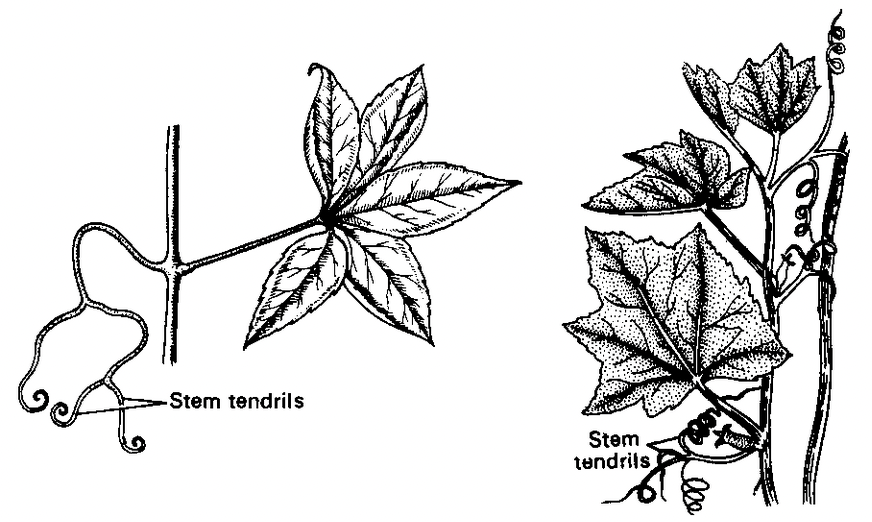
Fig. Stem tendrils
FUNCTIONS OF STEM |
Fig. Bulbil |
Functions of stem can be studied under following two headings:
❒ Normal functions
- Bearing: It bears branches, leaves, flowers, fruits, etc.
- Mechanical support: It keeps the plant in upright position.
- Conduction: Water and minerals absorbed by roots, are conducted to all parts of plants by stem.
- Transportation: The organic food synthesized by leaves is translocated to root and other parts through stem.
Special functions
- Storage of food: Underground and few aerial stems (e.g., sugarcane) serve as storage organs, and store food in their parenchymatous cells.
- Water storage: In xerophytes, stems store enough water.
- Perennation: Underground stems like rhizomes and corms, besides food storage, also serve as perennating organs. On the arrival of favourable conditions the axillary buds, present in the axils of scale leaves, germinate and form new plants.
- Vegetative propagation: Modified stems also help in vegetative reproduction.
- Photosynthesis: Some of the aerial modified stems like phylloclade and cladode manufacture food. In plants with scaly leaves (e.g., Casuarina) the stems have photosynthetic activity.
- Protection against browsing: By developing thorns, stem protects the plants from grazing animals.
- As climbers: By modifying into tendrils, hooks, etc. stem helps in climbing.

